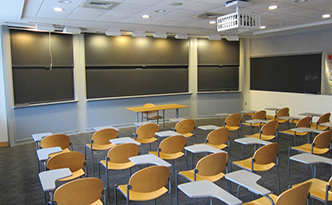Instructor Insights pages are part of the OCW Educator initiative, which seeks to enhance the value of OCW for educators.
Course Overview
This page focuses on the course 21A.445J Slavery and Human Trafficking in the 21st Century as it was taught by Mitali Thakor in Spring 2015.
This course explored the issue of human trafficking for forced labor and sexual slavery, focusing on its representation in recent scholarly accounts and advocacy as well as in other media. Students examined the wide range of factors and agents that enable human trafficking practices, such as technology, cultural practices, social and economic conditions, and the role of governments and international organizations.
Ethnographic and fictional readings along with media analysis helped to develop a contextualized and comparative understanding of the phenomena in both past and present contexts. Students discussed the analytical, moral and methodological questions of researching, writing, and representing trafficking and slavery.
Course Outcomes
Course Goals for Students
- Critically analyze the relationships between gender, sexuality, race, and class
- Read, listen to, and discuss literary and visual texts that highlight how slavery and human trafficking illuminate the interconnectedness of multiple systems of inequality and injustice
- Understand that slavery and human trafficking are live, and not purely academic, issues
My dissertation research is on trafficking, so it’s a topic I know very well, but I wasn’t used to teaching it or explaining it to others in such detail. Teaching the class allowed me to explore many elements of the topic that I don’t study myself. It took a lot of emotional energy to teach the class, but I loved the experience.
— Mitali Thakor
In the following pages, Mitali Thakor describes various aspects of how she taught 21A.445J Slavery and Human Trafficking in the 21st Century.
Curriculum Information
Prerequisites
None
Requirements Satisfied
- HASS-S

- 21A.445 can be applied toward a Bachelor of Science in Anthropology, Humanities and Engineering, or Humanities or Science, but is not required.
Assessment
The students' grades were based on the following activities:
 40% Term paper (outline, bibliography, revised draft)
40% Term paper (outline, bibliography, revised draft) 20% Attendance, preparation, and participation
20% Attendance, preparation, and participation 20% Weekly response memos
20% Weekly response memos 10% Small group meetings
10% Small group meetings 10% Small group final presentation
10% Small group final presentationStudent Information

Breakdown by Year
Mostly juniors and seniors
Breakdown by Major
Variety of majors
Typical Student Background
Many students had taken courses in women’s and gender studies or anthropology prior to enrolling in the class. Several Wellesley students participated and many of them were majoring in women’s and gender studies.
During an average week, students were expected to spend 12 hours on the course, roughly divided as follows:
Seminar
- Met twice a week for 1.5 hours per session; 24 sessions total; mandatory attendance.
- All students were expected to complete the readings, and participate in class discussions and activities. Activities included “fishbowl” exercises and a debate on the legalization of sex work in the US.
Out of Class
- Readings and screenings in preparation for class sessions
- 12 weekly response memos
- Small group meetings
- Small group final presentations
- Term paper
Semester Breakdown
| WEEK | M | T | W | Th | F |
|---|---|---|---|---|---|
| 1 |  |  |  |  |  |
| 2 |  |  |  |  |  |
| 3 |  |  |  |  |  |
| 4 |  |  |  |  |  |
| 5 |  |  |  |  |  |
| 6 |  |  |  |  |  |
| 7 |  |  |  |  |  |
| 8 |  |  |  |  |  |
| 9 |  |  |  |  |  |
| 10 |  |  |  |  |  |
| 11 |  |  |  |  |  |
| 12 |  |  |  |  |  |
| 13 |  |  |  |  |  |
| 14 |  |  |  |  |  |
| 15 |  |  |  |  |  |
| 16 |  |  |  |  |  |
 No classes throughout MIT
No classes throughout MIT Seminar
Seminar Small group presentations
Small group presentations Guest discussion
Guest discussion No class session scheduled
No class session scheduled Screening
Screening Debate
Debate Due dates
Due dates

 Room 1 of 1
Room 1 of 1 